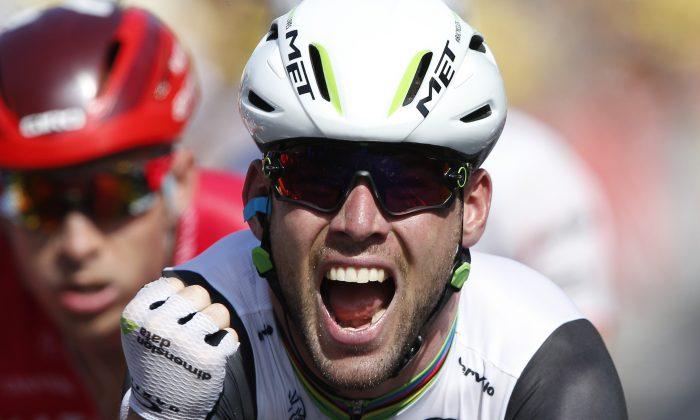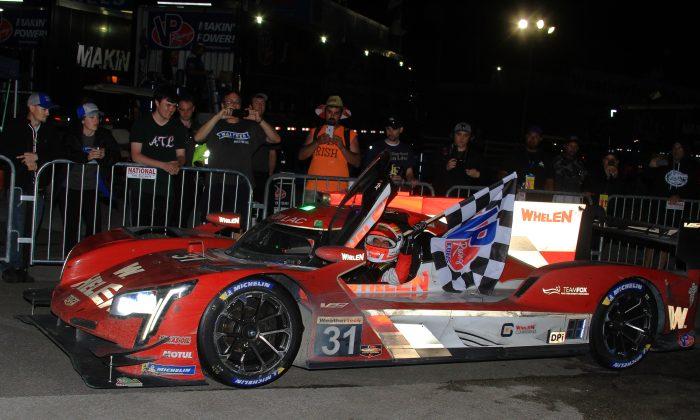Dimension Data sprinter Mark Cavendish once again proved his renewed power, coming from deep in the field to overtake Etixx-Quickstep’s Marcel Kittel, and Fortuneo-Vital Concept’s Dan McLay to win Stage Six of the 2016 Tour de France. The Manx Missile has now won three stages in the 2016 Tour, and 29 Tour stages in his career.
While the teams of André Greipel, Bryan Coquard, Alexander Kristoff, and Dylan Groenewegen fought hard to control the peloton through the final few kilometers, Kittel and Cavendish hung back, looking for openings while avoiding potential chaos—and there was plenty of chaos, with riders shouldering and shoving one another, fighting for position.
Etixx charged down the right side of the peloton 1500 meters from the finish, with Kittel tucking in behind Tinkoff’s Peter Sagan just past the one-kilometer banner, with Cavendish struggling to catch Kittel’s wheel.
Kittel was the first to attack, coming around Sagan and Kristoff. Cavendish followed Kittel through, pulled up on his left, and edged ahead an inch or two with each pedal stroke, crossing the line several inches ahead of the big German sprinter.

Third place went to Dan McLay of the Pro Continental Fortuneo-Vital Concept team. McLay showed an amazing turn of speed, hanging back until the final few dozen meters and very nearly catching Kittel for second place.
“That was terrifying—that was like the old days, wheel-surfing,” Mark Cavendish told NBCSN. “I was a little too far back, and it was just carnage everywhere, with guys twisting and turning.
“I wanted Kittel’s wheel. Quickstep wasn’t organized but I knew they would get it, and it was the right choice.”

Up Next: Going Up
The Tour takes a sharp upward turn starting with Stage Seven, the first of three very hard days in the Pyrenees mountains.
Stage Seven, 162.5 km from L‘Isle-Jourdain to Lac de Payolle, is the least challenging of the three Pyrenees stages, with only two categorized climbs: the Cat 4 Côte de Capvern followed by the Cat 1 Col d’Aspin, 12 kilometers at 6.5%—followed by a steep six-kilometer descent and a short uphill finish.
Stage Seven should offer some entertaining racing but shouldn’t affect the outcome of the race. This will be a stage where of the smaller team’s GC riders to try to steal a few seconds, possibly; it will certainly be a stage for breakaway riders and riders looking to enhance their careers to make bravura attacks on Col d'Aspin. No serious GC contender will be allowed to escape here, and it is likely none will try—not with the two brutal stages to follow.

This stage could reveal the likely future for Tinkoff’s Alberto Contador. The two-time Tour winner was visibly struggling up Cat 2 and Cat 3 climbs in Stage Five, suffering from severe bruising and abrasions of his right shoulder and bruising to his legs incurred in crashes in the first two stages. Getting out of the saddle to attack or defend seemed to be impossibly painful for the 33-year-old Grand Tour specialist.
If he has managed to recuperate somewhat during the relatively unchallenging (for a climber) Stage Six, he might be able to hold on through Stage Seven. if not, he could lose enough time to be completely out of the running for a podium place this year—a huge loss for Contador and a bigger loss for the Tour and its hundreds of millions of fans.
Contador will doubtless stick it out and fight for stage wins in the final week regardless of how he fares in the next three stages, but if he cannot keep up with the other GC contenders, 2016 will mark the second year when a head-to-head battle between the era’s two greatest Grand Tour riders, Contador and Sky’s Chris Froome, was obviated by injury.






